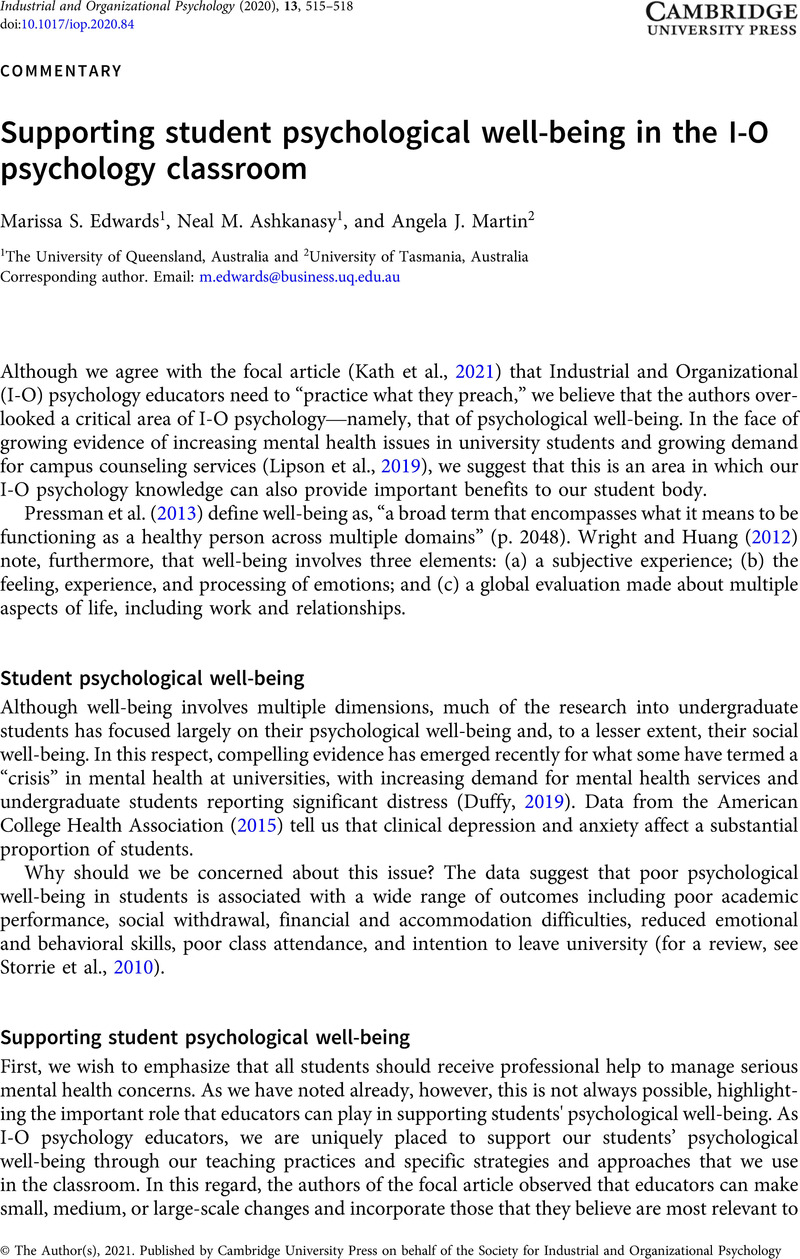No CrossRef data available.
Article contents
Supporting student psychological well-being in the I-O psychology classroom
Published online by Cambridge University Press: 08 February 2021
Abstract
An abstract is not available for this content so a preview has been provided. Please use the Get access link above for information on how to access this content.

- Type
- Commentaries
- Information
- Copyright
- © The Author(s), 2021. Published by Cambridge University Press on behalf of the Society for Industrial and Organizational Psychology
References
American College Health Association. (2015). American College Health Association-National College Health Assessment II: Reference Group executive summary Spring 2015. Hanover, MD: American College Health Association. Retrieved from http://www.acha-ncha.org/docs/ncha-ii_web_spring_2015_reference_group_executive_summary.pdf.Google Scholar
Barry, K. M., Woods, M., Martin, A., Stirling, C., & Warnecke, E. (2019). A randomized controlled trial of the effects of mindfulness practice on doctoral candidate psychological status. Journal of American College Health, 67(4), 299–307.CrossRefGoogle ScholarPubMed
Bishop, S. R., Lau, M., Shapiro, S., Carlson, L., Anderson, N. D., Carmody, J., Segal, Z. V., Abbey, S., Speca, M., Velting, D., & Devins, G. (2004). Mindfulness: A proposed operational definition. Clinical Psychology: Science and Practice, 11(3), 230–241Google Scholar
Duffy, A. (2019). University student mental health care is at the tipping point. The Conversation. https://theconversation.com/university-student-mental-health-care-is-at-the-tipping-point-122743
Google Scholar
Gronholm, P. C. Henderson, C. Deb, T. & Thornicroft, G. (2017). Interventions to reduce discrimination and stigma: The state of the art. Social Psychiatry and Psychiatric Epidemiology, 52(3), 249–258.CrossRefGoogle ScholarPubMed
Kath, L., Salter, N., Bachiochi, P., Brown, K., & Hebl, M. (2021). Teaching I-O psychology to undergraduate students: Do we practice what we preach? Industrial and Organizational Psychology: Perspectives on Science and Practice, 13(4), 443–460.Google Scholar
Lipson, S. K., Lattie, E. G., & Eisenberg, D. (2019). Increased rates of mental health service utilization by U.S. college students: 10-year population-level trends (2007–2017). Psychiatric Services, 70(1), 60–63.CrossRefGoogle Scholar
Pressman, S. D., Kraft, T., & Bowlin, S. (2013). Well-being: Physical, psychological, social. In Gellman M. D. & Turner J. R. (Eds), Encyclopedia of Behavioral Medicine (pp. 2047–2052). New York, NY: Springer.Google Scholar
Shann, C., Martin, A., Chester, A., & Ruddock, S. (2019). Effectiveness and application of an online leadership intervention to promote mental health and reduce depression-related stigma in organizations. Journal of Occupational Health Psychology, 24(1), 20–35.CrossRefGoogle ScholarPubMed
Storrie, K., Ahern, K., & Tuckett, A. (2010). A systematic review: Students with mental health problems—a growing problem. International Journal of Nursing Practice, 16(1), 1–6.CrossRefGoogle ScholarPubMed
Viswesvaran, C., Sanchez, J. I., & Fisher, J. (1999). The role of social support in the process of work stress: A meta-analysis. Journal of Vocational Behavior, 54(2), 314–334.CrossRefGoogle Scholar
Wright, T. A., & Huang, C. (2012). The many benefits of employee well-being in organizational research. Journal of Organizational Behavior, 33(8), 1188–1192.CrossRefGoogle Scholar




